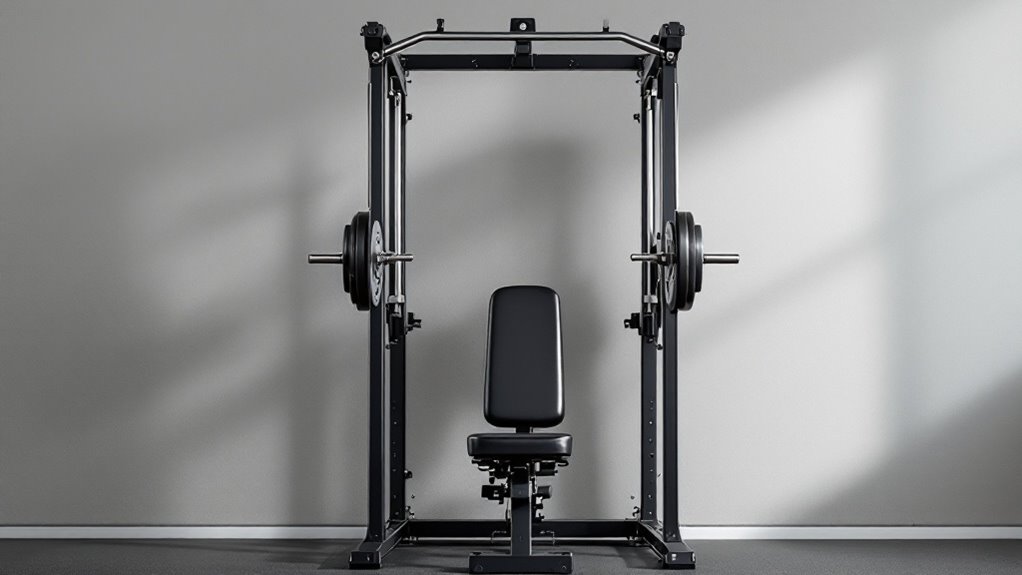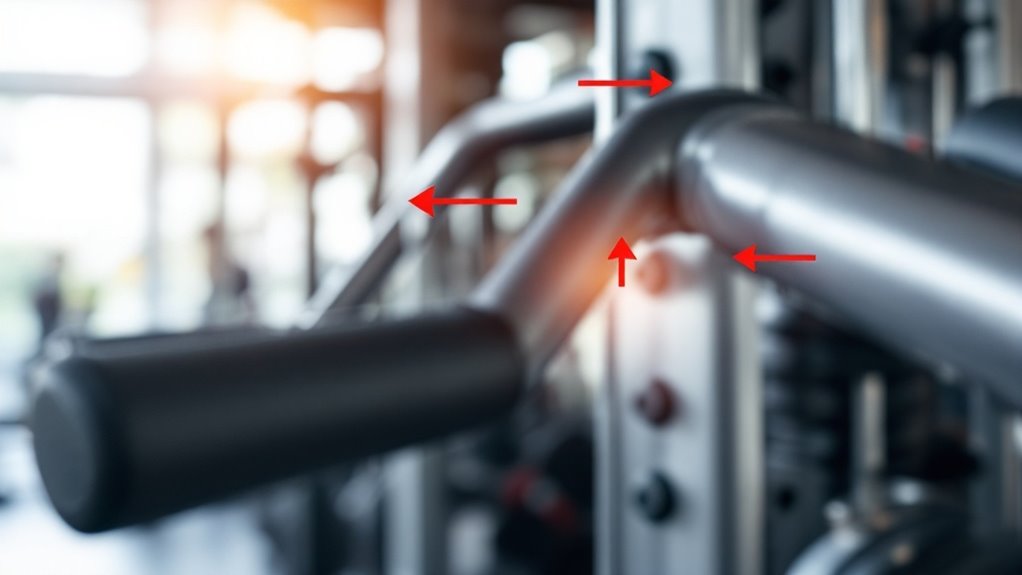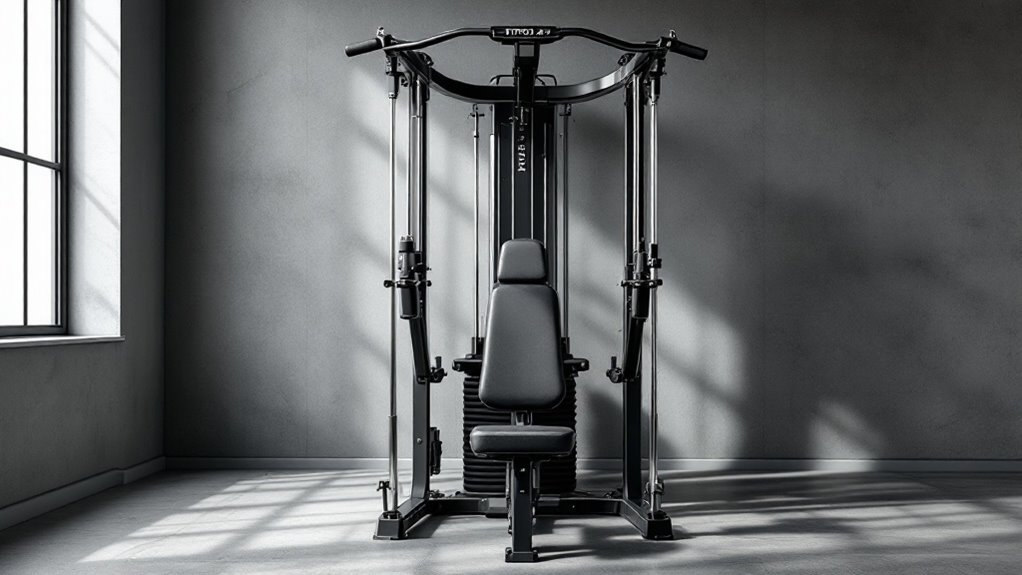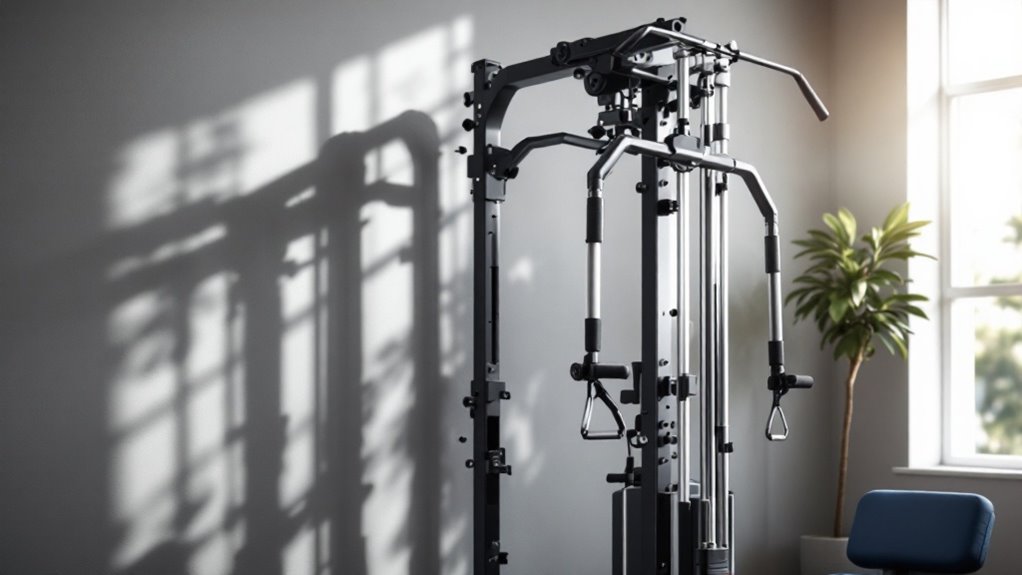Seated Lat Pull Downs

Seated lat pull downs are a powerful compound exercise targeting the latissimus dorsi muscles for building upper body strength and achieving a V-taper physique. Using proper form, athletes grip the bar slightly wider than shoulder-width, pulling it to the upper chest while maintaining core involvement and controlled movement. This exercise activates multiple muscle groups including rhomboids, trapezius, and rear deltoids while improving posture and pulling strength. Mastering the fundamentals releases advanced variations for maximum muscle development.
Key Takeaways
- Grasp the bar with a wide overhand grip and pull down to the upper chest while keeping elbows pointing downward.
- Secure your thighs under the pad and maintain an upright posture throughout the movement.
- Focus on engaging your latissimus dorsi muscles by squeezing your shoulder blades together during the downward motion.
- Control the weight during both lowering and raising phases, avoiding swinging or jerking movements.
- Start with manageable weights to master proper form before increasing resistance for optimal muscle development.
Proper Form and Technique

Mastering proper form and technique for seated lat pull downs is essential for maximizing muscle development while preventing injury.
Begin by adjusting the thigh pad to secure your legs and selecting an appropriate weight that allows controlled movement.
Grasp the bar with a wide overhand grip, slightly wider than shoulder-width. Keep your chest up and core involved throughout the movement.
Pull the bar down toward your upper chest while keeping your elbows pointed toward the floor, not flaring outward. Squeeze your lats at the bottom of the movement before slowly controlling the bar back to the starting position.
For optimal results, perform this exercise as part of a full body workout routine three times per week with rest days in between sessions.
Common Mistakes to Avoid

Several common mistakes can undermine the effectiveness of seated lat pull downs and potentially lead to injury.
Using excessive weight often leads to swinging and momentum-based movements instead of controlled contractions. Leaning too far back turns the exercise into an improper row movement, while pulling the bar behind the neck places dangerous stress on the shoulders and spine.
Proper form and controlled movements are essential during lat pulldowns – avoid swinging, excessive lean, or behind-the-neck variations for safety.
Other errors include gripping the bar too wide or narrow, failing to activate the core throughout the movement, and rushing through repetitions without proper mind-muscle connection.
Lifters should also avoid jerking the weight down or releasing it too quickly on the eccentric portion.
Regular triceps stretching routines can help improve your range of motion and prevent injuries during lat pull downs.
Muscles Worked and Benefits

The seated lat pull down targets multiple major muscle groups while offering significant strength and aesthetic benefits when performed correctly. The exercise primarily involves the latissimus dorsi muscles, creating that coveted V-taper physique. Furthermore, it works the rhomboids, trapezius, and rear deltoids.
Beyond aesthetic improvements, this movement improves pulling strength for everyday activities and other exercises. Regular performance builds upper body stability, improves posture, and develops core strength.
For beginners, it serves as an excellent progression toward mastering pull-ups, while advanced athletes can use it to maintain back strength and muscle development. Women can benefit greatly from this exercise as it helps build lean muscle mass without creating an overly bulky appearance.
Variations and Modifications

Commonly performed variations of the seated lat pull down allow exercisers to target different angles and muscle fibers while maintaining the core benefits of the movement. By adjusting grip width, hand position, and attachment type, individuals can customize their workout for specific goals. Following a progressive intensity plan helps ensure proper form development before attempting advanced variations.
| Variation | Target Area |
|---|---|
| Wide Grip | Outer Lats |
| Close Grip | Inner Lats/Biceps |
| Behind Neck | Upper Back/Traps |
Advanced modifications include single-arm pulls, tempo changes, and resistance band additions. These variations help prevent training plateaus and muscle adaptation while maintaining proper form and technique. Each modification serves a specific purpose in developing back strength and muscle definition.
Frequently Asked Questions
How Many Sets and Reps Should I Do for Lat Pull-Downs?
A standard approach is 3-4 sets of 8-12 repetitions with proper form and controlled movement.
Beginners should start with lighter weights, focusing on technique before progression. Advanced lifters might incorporate varying rep ranges, like 4 sets of 6-8 reps for strength or 3 sets of 12-15 for endurance.
Rest periods between sets should be 60-90 seconds for ideal muscle recovery.
Can I Do Lat Pull-Downs if I Have a Shoulder Injury?
A shoulder injury can feel like carrying a mountain of bricks on one side, making exercise decisions critical.
Working out with a shoulder injury requires medical clearance first. A physical therapist or doctor should evaluate the specific injury and determine if lat pull-downs are safe.
Modified versions, lighter weights, or alternative exercises might be recommended based on injury severity and healing stage.
What Weight Should Beginners Start With for Lat Pull-Downs?
Beginners should start with 30-40% of their body weight for proper form development.
For example, a 150-pound person would begin with 45-60 pounds.
Test the weight by completing 12-15 controlled reps with perfect form.
If maintaining proper technique becomes difficult before reaching 12 reps, reduce the weight.
Gradually increase weight by 5-10 pounds when 15 reps become easy.
Is It Normal to Feel Lat Pull-Downs More in My Arms?
Feeling the exercise more in the arms initially is common among beginners. This usually indicates improper form or mind-muscle connection.
To better target the lats, focus on pulling with the elbows rather than the hands, and imagine squeezing oranges in the armpits. Widening the grip slightly and leaning back 10-15 degrees can also help activate the lats more effectively during the movement.
How Often Should I Include Lat Pull-Downs in My Workout Routine?
For ideal muscle development and recovery, incorporate lat pull-downs 2-3 times per week with at least one day of rest between sessions.
Most training programs position this exercise on "back day" or "pull day."
Beginners should start with 3 sets of 10-12 reps, while more advanced lifters can adjust volume and frequency based on their overall program design and recovery capacity.
Final Thoughts
Research consistently demonstrates that seated lat pull downs are among the most effective exercises for developing upper body strength and muscle mass when performed correctly. While free-weight alternatives like pull-ups offer similar benefits, the controlled nature of cable machines makes lat pull downs particularly valuable for beginners and intermediate lifters. By mastering proper form and progressing systematically, this exercise remains a cornerstone for building impressive back development and functional strength.


